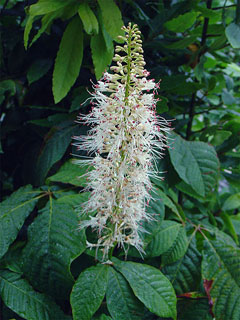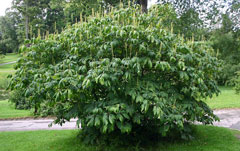 |
|
http://commons.wikimedia.org/wiki/User:Francis7 |
 |
| http://commons.wikimedia.org/wiki/User:Sten |
Translate this page:
Summary
Bloom Color: White.
Main Bloom Time: Early summer, Mid summer. Form: Rounded.
Physical Characteristics

 Aesculus parviflora is a deciduous Shrub growing to 4 m (13ft) by 4 m (13ft) at a slow rate.
Aesculus parviflora is a deciduous Shrub growing to 4 m (13ft) by 4 m (13ft) at a slow rate.
See above for USDA hardiness. It is hardy to UK zone 5 and is not frost tender. It is in flower in August, and the seeds ripen from October to November. The species is hermaphrodite (has both male and female organs) and is pollinated by Bees.
Suitable for: light (sandy), medium (loamy) and heavy (clay) soils and prefers well-drained soil. Suitable pH: mildly acid, neutral and basic (mildly alkaline) soils. It can grow in full shade (deep woodland) semi-shade (light woodland) or no shade. It prefers moist soil.
UK Hardiness Map
US Hardiness Map
Synonyms
Ae macrostachya. Pavia macrostachya
Plant Habitats
Woodland Garden Dappled Shade; Shady Edge; Ground Cover;
Edible Uses
Edible Parts: Seed
Edible Uses:
Seed - cooked[2, 22, 105, 177]. It can be dried and ground into a powder and used as a gruel. The seed is quite large and easily harvested, though it is rarely produced in Britain[11]. Unfortunately, it is rich in bitter-tasting saponins and these need to be leached out before the seed can be eaten. See notes on toxicity above. The following notes apply to A. californica, but are probably also relevant here:- The seed needs to be leached of toxins before it becomes safe to eat - the Indians would do this by slow-roasting the nuts (which would have rendered the saponins harmless) and then cutting them into thin slices, putting them into a cloth bag and rinsing them in a stream for 2 - 5 days[213]. Most of the minerals etc would also have been leached out by this treatment[K].
References More on Edible Uses
Medicinal Uses
Plants For A Future can not take any responsibility for any adverse effects from the use of plants. Always seek advice from a professional before using a plant medicinally.
Antiperiodic Antirheumatic Miscellany
Antiperiodic, antirheumatic[194]. Used in the treatment of colic, piles, constipation and whooping cough[194].
References More on Medicinal Uses
The Bookshop: Edible Plant Books
Our Latest books on Perennial Plants For Food Forests and Permaculture Gardens in paperback or digital formats.

Edible Tropical Plants
Food Forest Plants for Hotter Conditions: 250+ Plants For Tropical Food Forests & Permaculture Gardens.
More

Edible Temperate Plants
Plants for Your Food Forest: 500 Plants for Temperate Food Forests & Permaculture Gardens.
More

More Books
PFAF have eight books available in paperback and digital formats. Browse the shop for more information.
Shop Now
Other Uses
Miscellany Soap Wood
Saponins contained in the seed are used a soap substitute[169]. The saponins can be easily obtained by chopping the seed into small pieces and infusing them in hot water. This water can then be used for washing the body, clothes etc. Its main drawback is a lingering odour of horse chestnuts[K]. Plants can be used as a tall ground cover for large areas of land[208]. They are slow to establish but eventually form large spreading clumps[208]. Wood - easily worked. Used for making water troughs, packing cases, tea boxes, ornamental articles etc[194].
Special Uses
Ground cover Scented Plants
References More on Other Uses
Cultivation details
Landscape Uses:Border, Massing, Specimen, Woodland garden. Prefers a deep loamy well-drained soil but is not too fussy[1, 11]. Succeeds in most situations in sun or shade[126, 200]. Plants are very shade tolerant[200]. A very ornamental plant[1, 11], it is hardy to about -20°c[184] though it is slow to establish[208]. The young growth in spring can be damaged by late frosts. The flowers have a delicate honey perfume[245]. This species does best on the western side of Britain according to one report[126] whilst another says that it is best in a continental climate, which would suggest that it was best grown in the eastern half of the country[200]. Trees rarely fruit in Britain except after a long hot, dry summer[11, 130]. Spreads freely by suckers[182]. Grows well on a lawn[11]. Most members of this genus transplant easily, even when fairly large[11]. Special Features:Attractive foliage, North American native, All or parts of this plant are poisonous, Wetlands plant, Blooms are very showy.
References Carbon Farming Information and Carbon Sequestration Information
Temperature Converter
Type a value in the Celsius field to convert the value to Fahrenheit:
Fahrenheit:
The PFAF Bookshop
Plants For A Future have a number of books available in paperback and digital form. Book titles include Edible Plants, Edible Perennials, Edible Trees,Edible Shrubs, Woodland Gardening, and Temperate Food Forest Plants. Our new book is Food Forest Plants For Hotter Conditions (Tropical and Sub-Tropical).
Shop Now
Plant Propagation
Seed - best sown outdoors or in a cold frame as soon as it is ripe[11, 80]. The seed germinates almost immediately and must be given protection from severe weather[130]. The seed has a very limited viability and must not be allowed to dry out. Stored seed should be soaked for 24 hours prior to sowing and even after this may still not be viable[80, 113]. It is best to sow the seed with its 'scar' downwards[130]. If sowing the seed in a cold frame, pot up the seedlings in early spring and plant them out into their permanent positions in the summer. Root cuttings 5 - 7 cm long in December. Store the roots upside down in sand and pot them up in March/April[78]. Grow them on until they are 20cm or more tall and then plant them out into their permanent positions, preferably in late spring or early summer after the last expected frosts. Division of suckers in the dormant season[200]. The suckers can be planted out direct into their permanent positions if required.
Other Names
If available other names are mentioned here
Native Range
NORTHERN AMERICA: United States (Alabama, Georgia, South Carolina)
Weed Potential
Right plant wrong place. We are currently updating this section.
Please note that a plant may be invasive in one area but may not in your area so it's worth checking.
Conservation Status
IUCN Red List of Threatened Plants Status :

Growth: S = slow M = medium F = fast. Soil: L = light (sandy) M = medium H = heavy (clay). pH: A = acid N = neutral B = basic (alkaline). Shade: F = full shade S = semi-shade N = no shade. Moisture: D = dry M = Moist We = wet Wa = water.
Now available:
Food Forest Plants for Mediterranean Conditions
350+ Perennial Plants For Mediterranean and Drier Food Forests and Permaculture Gardens.
[Paperback and eBook]
This is the third in Plants For A Future's series of plant guides for food forests tailored to
specific climate zones. Following volumes on temperate and tropical ecosystems, this book focuses
on species suited to Mediterranean conditions—regions with hot, dry summers and cool, wet winters,
often facing the added challenge of climate change.
Read More
Expert comment
Author
Walter.
Botanical References
1172200
Links / References
For a list of references used on this page please go here
Readers comment
| Add a comment |
|
If you have important information about this plant that may help other users please add a comment or link below. Only comments or links that are felt to be directly relevant to a plant will be included. If you think a comment/link or information contained on this page is inaccurate or misleading we would welcome your feedback at [email protected]. If you have questions about a plant please use the Forum on this website as we do not have the resources to answer questions ourselves.
* Please note: the comments by website users are not necessarily those held by PFAF and may give misleading or inaccurate information.
To leave a comment please Register or login here All comments need to be approved so will not appear immediately.
|
Subject : Aesculus parviflora
|
|
|
|